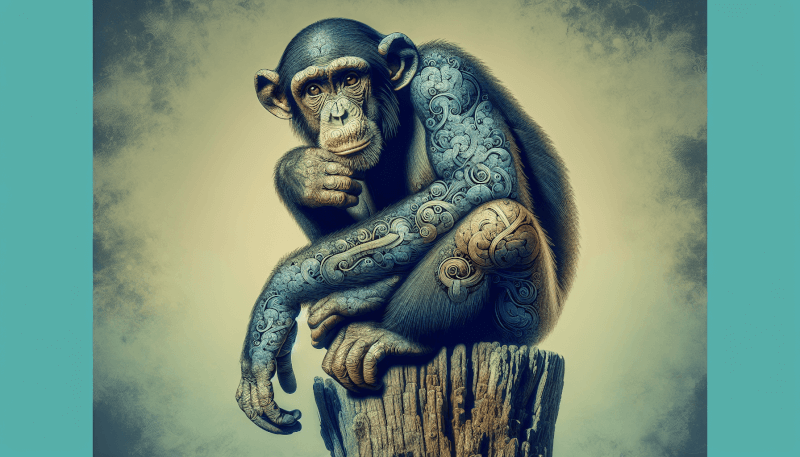In the world of primates, social hierarchy plays a vital role in shaping their emotional well-being. This article sheds light on the influence of social ranking among primates, exploring the intricate dynamics that contribute to their emotional states. From alpha leaders to lower-ranking individuals, the social structure greatly impacts how primates feel and interact with one another. By understanding the impact of social hierarchy on their emotional well-being, we gain valuable insights into the complex world of primate behavior. So, buckle up and prepare to delve into the fascinating realm of primate social dynamics!

Definition of Social Hierarchy
Explanation of social hierarchy in primate societies
Social hierarchy refers to the ranking system that exists within primate societies, where individuals are classified based on their social status and authority. It determines the access to resources, reproductive opportunities, and overall influence an individual has within the group. Primate social hierarchies are often characterized by dominant individuals, who hold high-ranking positions, and subordinate individuals, who occupy lower positions in the hierarchy.
Examples of primate species with well-established social hierarchies
There are several primate species that exhibit well-established social hierarchies. One such example is the chimpanzee, where dominant individuals establish their status through displays of aggression, grooming, and vocalizations. Bonobos also have a social hierarchy, but it is more fluid, with less aggression and more emphasis on social bonding. In baboons, social ranking is based on a combination of age, size, and aggression, where dominant individuals enjoy preferential access to resources and reproductive opportunities. These examples highlight the varied nature of social hierarchies among different primate species.
Social Hierarchy and Stress Levels
Effects of social status on stress levels in primates
Research has shown that social status significantly influences stress levels in primates. Individuals occupying higher positions in the hierarchy often experience lower stress levels, while those in subordinate positions tend to be more stressed. The dominant individuals enjoy better access to food, mating partners, and social support, which contribute to their lower stress levels. On the other hand, subordinate individuals face resource competition, aggression, and social exclusion, leading to chronic stress.
Study findings on cortisol levels in primates with different ranks within the hierarchy
Cortisol, a hormone associated with stress, is often used as a measure to assess the impact of social hierarchy on primates’ stress levels. Studies have shown that individuals with higher social status exhibit lower cortisol levels compared to subordinate individuals. This indicates that the stress response is mitigated in dominant individuals, while subordinate individuals experience heightened stress levels. These findings provide further evidence of the influence social hierarchy has on the well-being of primates.
Emotional Well-being and Social Ranking
Correlation between social ranking and emotional well-being in primates
There is a clear correlation between social ranking and emotional well-being in primates. Dominant individuals, who hold higher positions in the social hierarchy, tend to exhibit more positive emotional states, such as confidence, happiness, and contentment. In contrast, subordinate individuals often display negative emotional states, including fear, anxiety, and depression. This correlation suggests that social standing plays a significant role in shaping the emotional well-being of primates.
Observations of mental health in dominant vs. subordinate primates
Observations of primate behavior have revealed stark differences in mental health between dominant and subordinate individuals. Dominant primates exhibit higher levels of self-assurance, engage in more social interactions, and display fewer signs of stress or mental distress. On the other hand, subordinate primates often exhibit signs of submissiveness, withdrawal, and heightened vigilance. These observations highlight the impact of social hierarchy on the overall mental health and well-being of primates.
Challenges Faced by Low-ranking Primates
Experiences of low-ranking individuals in primate groups
Low-ranking individuals in primate groups face numerous challenges that significantly impact their emotional well-being. They often face resource scarcity, limited access to food and mates, and increased vulnerability to aggression from dominant individuals. The constant exposure to stressors such as social exclusion and harassment can lead to chronic stress and a compromised emotional state.
Effects of social exclusion on emotional well-being
Social exclusion, a common experience for low-ranking individuals, has detrimental effects on emotional well-being. When primates are socially isolated or excluded from group activities, they experience feelings of loneliness, rejection, and sadness. Social exclusion can also result in reduced social support and a lack of opportunities for social bonding, further contributing to poor emotional well-being among low-ranking primates.

Benevolent Leadership and Emotional Well-being
Impact of benevolent leaders on the emotional well-being of a primate group
Benevolent leaders, who exhibit positive behaviors and prioritize the welfare of the group, have a significant impact on the emotional well-being of a primate group. These leaders use their social status to promote fairness, resolve conflicts, and provide opportunities for social bonding. Their empathetic and cooperative nature fosters a more harmonious social environment, leading to improved emotional well-being for all group members.
Examples of positive behaviors exhibited by dominant individuals
Dominant individuals who contribute to the emotional well-being of their group exhibit several positive behaviors. They engage in affiliation behaviors, such as grooming and social bonding, to establish and maintain social relationships within the group. They also mediate conflicts, ensuring a peaceful resolution and reducing social tension. These positive behaviors create a sense of security and stability within the group, positively influencing the emotional well-being of all individuals.
Importance of Social Bonds
Role of social bonds in mitigating the negative effects of social hierarchy on emotional well-being
Social bonds play a crucial role in mitigating the negative effects of social hierarchy on the emotional well-being of primates. Strong social connections provide emotional support, reduce stress levels, and promote feelings of safety and belonging. Social bonds can counteract the adverse effects of social exclusion and aggression, enhancing the overall emotional well-being of both dominant and subordinate individuals.
Studies on the relationship between social support and mental health
Numerous studies have highlighted the positive impact of social support on the mental health of primates. Research has shown that individuals with strong social bonds are more resilient to stress, exhibit lower levels of anxiety and depression, and generally have better overall mental well-being. These findings emphasize the significance of social relationships in promoting emotional health and mitigating the negative effects of social hierarchy.

Influence of Social Hierarchy on Reproductive Success
How social hierarchy affects reproductive success in primates
Social hierarchy plays a crucial role in determining reproductive success in primates. Dominant individuals usually have preferential access to mating partners, increasing their reproductive opportunities. They also enjoy priority access to resources, allowing them to provide better care for their offspring. In contrast, subordinate individuals face challenges in accessing mates and limited resources, which can significantly impact their reproductive success.
Links between social standing, mating opportunities, and offspring survival
The higher social standing of dominant individuals affords them increased mating opportunities, leading to greater reproductive success. In addition, their access to resources allows for better provisioning of offspring, increasing the chances of offspring survival and overall reproductive success. Subordinate individuals, however, often have fewer mating opportunities and face higher risks of offspring mortality due to limited resources, reducing their overall reproductive success.
Interactions Between Hierarchy and Physical Health
Connections between social hierarchy, stress, and physical health in primates
There is a significant connection between social hierarchy, stress, and physical health in primates. The chronic stress experienced by subordinate individuals due to social inequality and the lack of access to resources has been linked to various health problems. High stress levels can weaken the immune system, increase susceptibility to diseases, and negatively impact overall physical health. Thus, social hierarchy has a profound influence on both emotional and physical well-being in primates.
Study findings on the relationship between social status and disease susceptibility
Numerous studies have demonstrated a relationship between social status and disease susceptibility in primates. Lower-ranking individuals often experience higher rates of disease and have reduced immune function compared to dominant individuals. This is attributed to the cumulative effects of chronic stress, limited access to resources, and increased exposure to aggression. These findings underscore the detrimental impact of social hierarchy on the physical health of primates.

Interventions to Improve Primates’ Emotional Well-being
Approaches to promote better emotional well-being for primates in captivity
To promote better emotional well-being for primates in captivity, several approaches have been implemented. Providing enrichments that mimic natural habitat, such as climbing structures, foraging opportunities, and socialization with conspecifics, can help alleviate stress and improve overall well-being. Proper healthcare, nutrition, and veterinary care also play crucial roles in maintaining emotional well-being. Additionally, implementing positive reinforcement training techniques can enhance the social bond between caretakers and primates, further promoting their emotional well-being.
Examples of successful enrichment programs
Various successful enrichment programs have been implemented to improve the emotional well-being of primates in captivity. One example is the use of food puzzles, where primates are given devices that require problem-solving to access food rewards. This engages their natural foraging instincts and promotes mental stimulation. Another example is the provision of platforms and structures that allow for climbing and exploration, simulating the natural behaviors of primates. These successful enrichment programs demonstrate the positive impact of environmental and behavioral stimulation on primates’ emotional well-being.
Implications for Human Societies
Parallel between primate social hierarchies and human social structures
Primate social hierarchies bear striking parallels to human social structures. Both involve the classification of individuals based on social status and power dynamics, impacting access to resources, reproductive opportunities, and overall well-being. Understanding the impact of social hierarchy on primates’ emotional well-being can provide insights into similar issues faced by humans and serve as a foundation for promoting better emotional well-being in human societies.
Lessons learned from primate research for improving human emotional well-being
Primate research offers valuable lessons for improving human emotional well-being. It emphasizes the importance of social support, the impact of social inequality on emotional health, and the role of benevolent leadership in fostering positive environments. By prioritizing social connections, promoting fairness, and addressing social inequalities, humans can learn valuable strategies to enhance emotional well-being and create more compassionate and inclusive societies.
In conclusion, social hierarchy significantly impacts the emotional well-being of primates. From the effects on stress levels and mental health to reproductive success and physical health, social hierarchy influences various aspects of primates’ lives. Understanding the challenges faced by low-ranking individuals, the importance of social bonds, and the potential interventions to enhance emotional well-being provides insights into promoting better emotional well-being for both primates and humans. By learning from primate research, we can strive for more equitable and supportive societies that prioritize emotional well-being for all.



